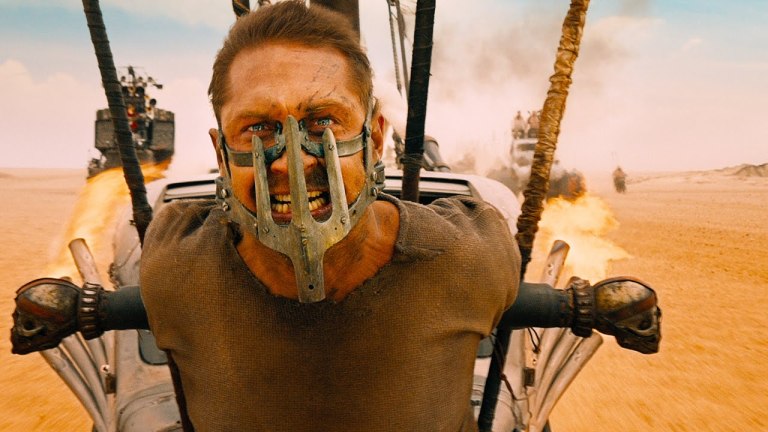Tom Hardy Says Mad Max: The Wasteland Isn’t Happening, and That’s a Tragedy
Tom Hardy casts heavy doubt on Mad Max: The Wasteland getting made. This would be a real shame if true… although George Miller still retains the rights.

In an early scene of Mad Max: Fury Road, the warrior called Furiosa (Charlize Theron in that film) stands in a shadowless patch of barren desert alongside several women who have been sheltered from the heat, if not misery, all their lives. One of them laments about a flesh wound she just suffered as they watch their last ride out of the Wasteland vanish into the horizon. “It hurts,” she whispers. “Out here everything hurts,” Furiosa responds. “Now pick up what you can and run.”
Fans and admirers of George Miller’s Mad Max films can probably relate to that feeling these days. In an act that still defies the rules of convention applied to aging artists—and certainly those prescribed by Quentin Tarantino—Miller has labored away at building his beautiful nightmare vision of our post-apocalyptic future for nearly 50 years. And in that time, a case can be made that his later Wasteland films are better than when he started this series with Byron Kennedy in 1979.
Mad Max: Fury Road is probably the most cinematic action film released in the last 20 years; an insane spectacle filled with viscerally unsafe-looking stunts that are captured with the visual clarity of a great silent film but edited to the kinetic frenzy one expects out of a filmmaker a third of Miller’s age. (He was 70 when the movie was released.) The film is an astonishing triumph, and one always meant to spawn two more films: a movie about the epic odyssey of Furiosa’s life before Fury Road… and one more adventure with its titular Max.
Yet like Furiosa and the brides of Immortan Joe, fans are left standing in the sun as the last symbol of hope appears to be fading into the distance. At least that is the impression the actor who played Mad Max in the 2015 film, Tom Hardy, left while speaking to Forbes. In an interview with Jeff Conway ahead of this weekend’s The Bikeriders, Hardy was asked about the prospect of still doing Mad Max: The Wasteland, a film which had at least a draft of a screenplay (or “novel” in Miller’s telling) finished back in the early 2010s, right along with the earliest version of the Furiosa script.
“I don’t think that’s happening” was Hardy’s curt and only attributed comment.
The news isn’t exactly shocking after the disappointing opening weekend and subsequent box office run of Furiosa: A Mad Max Saga last month. The underperformance of that prequel—as well as a historically weak May with releases like The Garfield Movie, If, and The Fall Guy—contributed to the worst Memorial Day weekend at the box office in decades. And after factoring in that Warner Bros. Pictures invested a reported $167 million in Furiosa, a figure that excludes marketing, it does not suggest the type of environment which begets another sequel or prequel.
This is hence a minor tragedy, at least in regards to those who enjoy genuinely exciting and innovative genre cinema.
While the health and vitality of movie franchises in the 21st century is almost always a commercial and corporate concern, a C-suite strategy determined by how best to squeeze every last drop of value out of an intellectual property, the Mad Max films have remained, rather miraculously, artistic and ambitious endeavors undertaken by Miller and anyone crazy enough to follow him into the desert each decade. This is a filmmaker who made it a lifetime crusade to build out the world of his earliest success by way of the grandest, and weirdest, of big screen mythologies. And we do not mean this in the modern “cinematic shared universe” sense, which studios still chase like the pot of gold at the end of a rainbow. Each Mad Max film, including Furiosa, plays like a different myth shared around the campfire; a beautiful fairytale awaiting us as a fleeting comfort in our predestined hell.
Whatever box office failings Furiosa endured will ultimately fade away from memory when compared to the movie that was built to last. Unlike most prequels, Furiosa stands on its own as a layered epic that’s novelistic and dense in structure (a first for a Mad Max-adjacent movie). It turns Furiosa into a figure every bit as mythic as Max. She’s also a fair bit more complex as Miller and star Anya Taylor-Joy create a decades-spanning portrait of the girl who can never go home.
Given the layers Furiosa added to its eponymous character, one cannot help but speculate what Mad Max: The Wasteland’s story might do for its titular character. Like Furiosa, Wasteland is reportedly a prequel about Max Rockatansky’s adventures before arriving on the Fury Road. The film would be set one year prior to the events of the 2015 movie and it is supposed to follow Max on what might be a fairly tragic adventure. Consider that it’s assumed by fans the little girl whom Hardy’s Max has visions of in Fury Road is supposed to be someone he might’ve met during The Wasteland. (It’s not his son.)
In any event, it might appear that Mad Max’s adventures have taken the war rig and left us behind. It’s understandable in the world of Hollywood bookkeeping to cut your losses. Fury Road only turned a marginal profit itself back in 2015 and was likely buoyed greatly by its enthusiastic reception with critics and the industry—it went on to be nominated for Best Picture and Best Director at the Oscars, where it won half a dozen technical awards. But a lot can change in a decade, and cinematic viewing habits may not favor more thrilling Wasteland madness (a bitter fact considering audiences are more than happy to turn up for more formulaic and empty franchise extensions, including still this summer).
… And yet, with all that said, we would like to point out one thing: George Miller retains the legal rights to the Mad Max character and the larger Wasteland intellectual property. It might be understandable for purely commercial reasons if Warner Bros. wants to get out of the Mad Max business following Furiosa’s box office run…. but Miller still has the ability to take the character and concept to anyone (or any type of distributor) who might be willing to follow Max on one last ride. He could even do it without Hardy if need be. Miller’s recast the character once before.
From the outside, this of course seems a trifle mad. Miller turns 80 next year, and Furiosa flopped. But given the stories behind the creation of Fury Road and Furiosa—and the fact he released the latter at the age of 79 and the former decades after the bizarre Mad Max Beyond Thunderdome—we’d say madness has always been this universe’s greatest asset. So maybe, just maybe, someone still can be convinced to follow this Aussie out into the desert.
